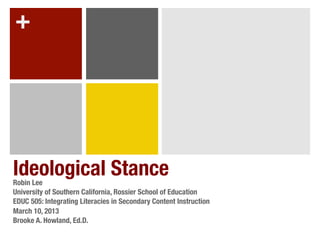
Ideological Stance
- 1. + Ideological Stance Robin Lee University of Southern California, Rossier School of Education EDUC 505: Integrating Literacies in Secondary Content Instruction March 10, 2013 Brooke A. Howland, Ed.D.
- 2. + Ideological Stance Inquiry science promotes students’ construction of meaning through exploration of scientific phenomenon, observations, experiments, and hands-on activities (Stoddart, Pinal, Latzke, & Canaday, 2002). Teachers should strive to create an equitable learning environment in which students can actively engage in inquiry science by incorporating each of their unique resources accumulated from prior experiences to science content. To create such a learning environment, teachers should integrate critical literacy strategies into science instruction to allow for differentiated instruction, where students can make connections between the content and their own understandings. Literacy strategies will also facilitate students in understanding the academic language used in science content.
- 3. + Differentiation In providing equity and access to content understanding.
- 4. + Differentiation Equity and Access n Differentiation adjusts instruction for all students, including underserved, learning disabled, gifted, and English language learners. n Integrating various critical literacy strategies into inquiry science provides students with opportunities to engage and access the content. n Students are not expected to find all literacy strategies effective. By introducing various strategies, the teacher provides students opportunities to find a strategy most effective for their own understandings.
- 5. + Learning Strategies & Theory
- 6. + Guiding Reading Comprehension: Think-Alouds n Think-alouds help students clarify their understanding of content reading through a metacognitive approach (Vacca, Vacca, & Mraz, 2011). n Students develop hypotheses by making predictions from the text. n This approach aligns with inquiry science, as students are questioning and constructing meaning. n Students should also be encouraged to work with partners in creating think-alouds. n Social cognitive learning theory suggests that students can learn by observing others (Ormrod, 2011). Thus, by allowing students to work with partners, students can more successfully understand content and further monitor their comprehension by sharing their interpretations of the text.
- 7. + Studying Text: Graphic Organizers/Semantic (Cognitive) Mapping n Graphic organizers help students comprehend and retain textually important information (Vacca et al., 2011). n In creating graphic organizers, students identify what parts of a text is important and how these ideas are related to one another. Meaning is constructed by the student not absorbed, which depicts the core of constructivism (Ormrod, 2011). n Semantic maps are an example of graphic organizers that visually illustrates the relationships associated with the core concepts of the content. n Graphic organizers create an equitable learning environment because students, regardless of whether they are English learners or special needs students, can explore the academic purpose of the text and organize their thoughts (Girard & Spycher, 2007).
- 8. + Writing to Learn (WTL): Double-Entry Journals (DEJs) n WTL activities help students tap into prior knowledge and make connections between the “old” and the “new” (Vacca et al., 2011). n Students explore ideas and clarify what they are thinking about in relation to content. n DEJs allow students to record dual entries that are conceptually related (Vacca et al., 2011). n In the left column of the journal, students may be prompted to write about a topic prior to class discussion, making connections with their prior knowledge. In the right column, students may write in their own language about what they are learning. n Through DEJs, students are engaging themselves in inquiry based learning, by making predictions and connections. n Because students are encouraged to write in their own language, it allows students to engage with the content through strategies most efficient for themselves. This allows for constructivism, in which students can regulate their own process of cognition (Ormrod, 2011).
- 9. + References Girard, V., & Spycher, P. (2007). Deconstructing language for English learners. Aiming High Resource: Aspirando a lo mejor. Santa Rosa, CA: Sonoma County Office of Education (SCOE). Ormrod, J.E. (2011). Education psychology: Developing learners (7th ed.). Upper Saddle River, NJ: Pearson. Stoddart, T., Pinal, A., Latzke, M., & Canaday, D. (2002). Integrating inquiry science and language development for English language learners. Journal of Research in Science Teaching (39)8, 664-687. Vacca, R.T., Vacca, J.L., & Mraz, M. (2011). Content area reading: Literacy and learning across the curriculum (10th ed.). Boston, MA: Pearson.